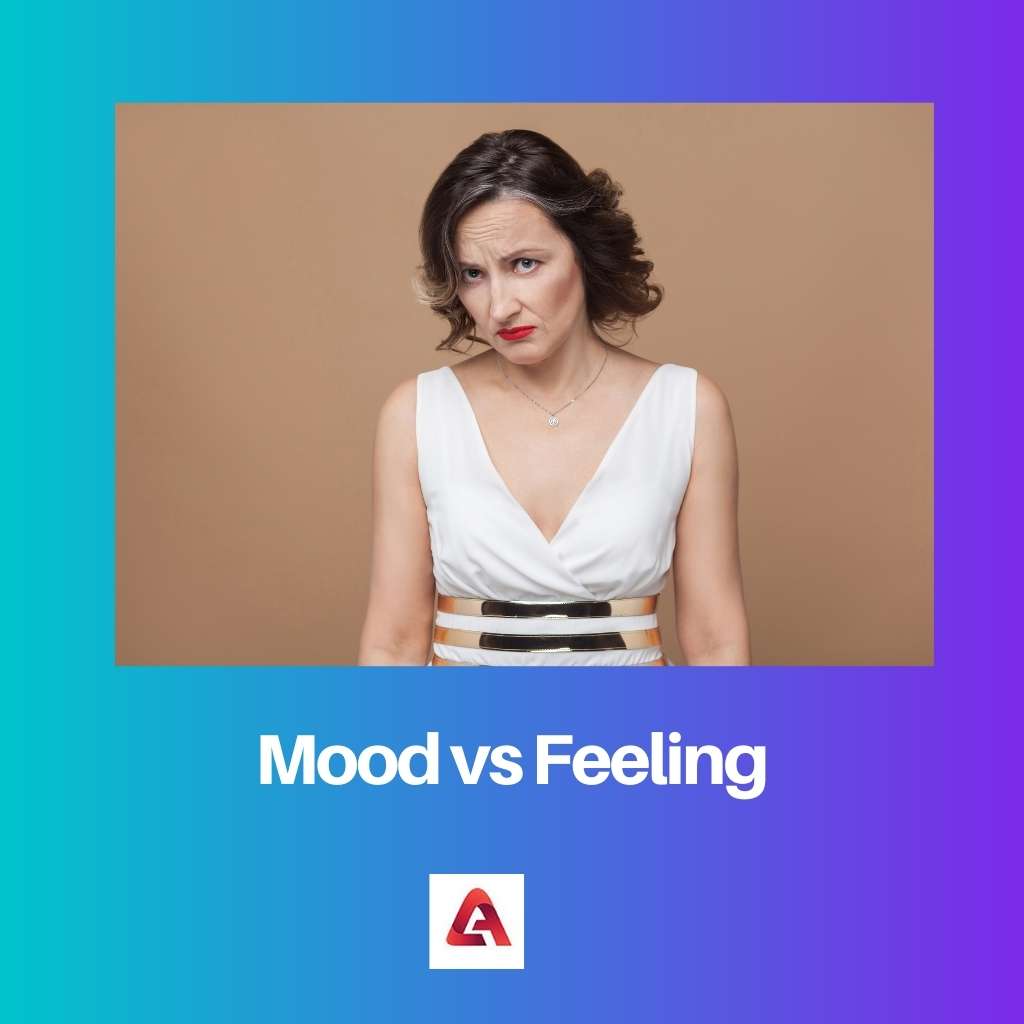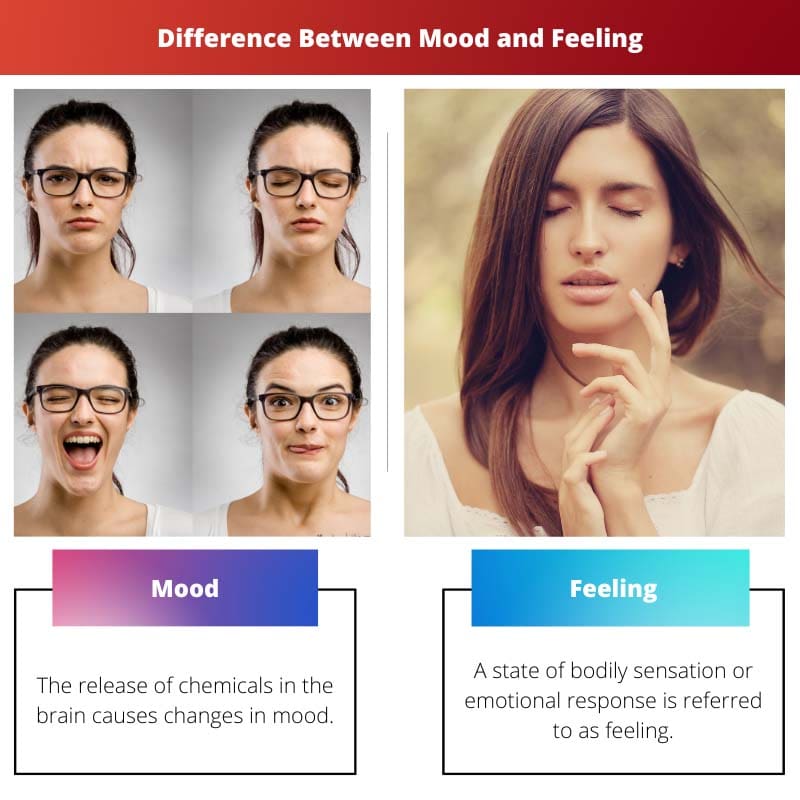Human beings are a kaleidoscope of feelings. They are full of emotions that are displayed in different ways depending on the situation.
When you are joyful, your emotion is happiness; when you are sad, your emotion is sadness. When you’re angry, you’re experiencing rage, as well as a variety of other emotions.
Because of these feelings, humans are superior to animals.
These emotions define a person’s subjective mental state and determine whether he or she is in a good or bad mood. For a human being, mood and feelings are two very significant experiences.
Key Takeaways
- The mood is a long-term emotional state, while the feeling is a short-term emotional response to a specific situation.
- The mood is less intense than the feeling.
- The mood is not necessarily tied to a specific event, while the feeling is tied to a particular experience.
Mood vs Feeling
Mood refers to a general emotional state. Feeling is a specific emotion that is experienced in response to a particular stimulus. Mood is described as a long-lasting emotional state, as happy or sad, while feeling is shorter in duration, as feeling joy or anger.

The mood is the individual’s emotional state, which is the underlying experience of emotion. It is less intense in an individual for a specified period of time.
It is less influenced by a specific stimulus or circumstance. The mood has two types of hedonic tones: positive and negative at one time.
A good mood or a bad mood is defined by a positive or negative tone, which can be caused by a variety of events.
Feelings are sensations that a person has as a result of his or her bodily contact with another person. This term “feeling” is a powerful and acute word, implying that something happens for a short period of time.
It has a strong connection with emotions. They are based on the subjective conscious sense of emotions.
Comparison Table
| Parameters of Comparison | Mood | Feeling |
|---|---|---|
| Meaning | The release of chemicals in the brain causes changes in mood. | A state of bodily sensation or emotional response is referred to as feeling. |
| Duration | It lasts for a long time, up to several days in some cases. | It does not endure for long periods of time, only seconds to minutes. |
| Active Brain Part | The amygdala, insula, and periaqueductal gray are brain areas that control mood. | The frontal lobe of the brain is where feelings begin. |
| Negative Effect | It can cause “mood-based disorders,” like depression, bipolar disorder, and many other mental disorders. | It can cause you self-harm if not controlled on time. |
| Example | The mood is of two types bad mood and good mood. | The feeling of trust, love, pain, happiness. |
What is Mood?
The mood is described as an individual’s emotional state that lasts for a longer period of time than feelings. This isn’t specific, but it is intense, and it can be triggered by a certain occurrence.
It can be both positive and negative, depending on the circumstances. People refer to this negative or positive tone of their mood as a good mood and bad mood in their daily routines.
A positive mood is caused by the situation, whereas a bad mood is also caused by the situation. An individual’s positive mood is influenced by several facts of life or a specific effect on the individual as a whole.
Some experiences, such as a restful night’s sleep, no tension, and a steady state of mind, can readily determine a good mood. It is impossible to determine the exact cause of a pleasant or positive attitude.
A person’s positive mindset has a significant impact on his or her cognitive mind. A positive mind is extremely beneficial since it boosts creative thinking and problem-solving abilities.
It allows people to think freely and come up with inventive and creative ideas. When a person is in a good mood, he is more likely to make wise decisions.
A negative mood, like a positive mood, is an important part of a person’s mental state. It’s a psychological state of mind brought on by a reaction to a scenario or event that has no external source.
There are no precise factors that contribute to a negative mood. It doesn’t have a set duration; it might endure for several hours, days, or even weeks while you’re anxious.
When a person is in a bad mood, it can have an adverse influence on their judgement and understanding of a situation. It has a low intensity when compared to a pleasant mood, but it has a strong grip on human emotion.
Many people suffer from sadness, anxiety, anger, and low self-esteem as a result of having a negative mood for a long time.

What is Feeling?
The feeling is also defined as the state of consciousness. It has occurred due to the physical sensation of touch through experience and perception.
It lasts for a short span of time. It is the cause of bodily changes.
Feelings are subjective and private. It cannot be seen by another person unstill expressed in front of them.
A gut feeling or gut reaction is a sensation that every human being has. It’s possible that your gut feeling is both bad and good.
You feel nervous and uncomfortable because of the unpleasant feelings. When you’re with someone who makes you feel at ease, a favourable emotion is one of trust, love, security, and a feeling of warmth.

Main Differences Between Mood and Feeling
- Bodily experience is referred to as “feeling,” but the emotional and mental condition of an individual is referred to as “mood.”
- On the one hand, the mood span is long, but the intensity is low; on the other hand, the emotion is acute, but the intensity is higher.
- Mood influences an individual’s decision-making depending on his or her good or bad mood, but feelings have no bearing on an individual’s decision-making.
- Feelings affect an individual’s emotional state, whereas mood can affect an individual’s mental health if they are constantly in a bad mood with negative thoughts.
- The mood is influenced by external factors such as the surrounding environment, although feelings are the least affected by it.

- https://psycnet.apa.org/record/1998-00299-001
- https://search.proquest.com/openview/ece7a8c2e4ad61aa68ec67ada35196ac/1?pq-origsite=gscholar&cbl=1819046
- https://www.tandfonline.com/doi/abs/10.1080/02699930143000266
